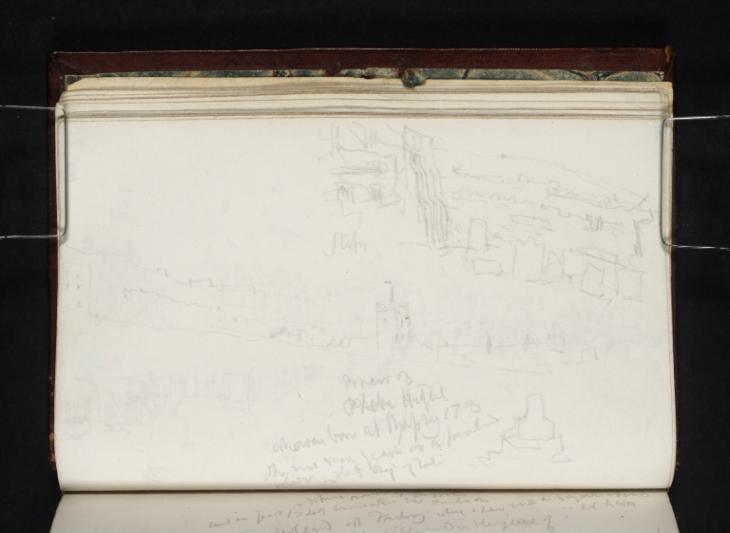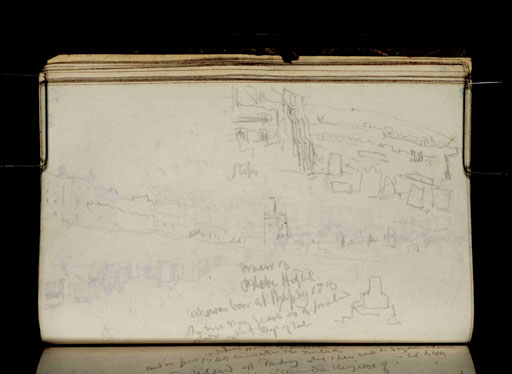Joseph Mallord William Turner View of Brighton from St Nicholas' Church c.1824
Image 1 of 2
Joseph Mallord William Turner,
View of Brighton from St Nicholas' Church
c.1824
Joseph Mallord William Turner 1775–1851
Folio 21 Verso:
View of Brighton from St Nicholas’ Church c.1824
D18346
Turner Bequest CCX 21a
Turner Bequest CCX 21a
Pencil on white wove paper, 75 x 118 mm
Inscribed in pencil by Turner ‘Steps’ centre towards top right, ‘grave of | Phoebe Hessel | who was born at Stepney 1713 | She was many years as a private | soldier with 5 Regt of Foot’ rear centre towards right
Inscribed in pencil by Turner ‘Steps’ centre towards top right, ‘grave of | Phoebe Hessel | who was born at Stepney 1713 | She was many years as a private | soldier with 5 Regt of Foot’ rear centre towards right
Accepted by the nation as part of the Turner Bequest 1856
References
1909
A.J. Finberg, A Complete Inventory of the Drawings of the Turner Bequest, London 1909, vol.II, p.636, CCX 21a, as ‘Churchyard, &c.’.
1995
David Beevers (ed.), John Roles, Ian Warrell and others, Brighton Revealed: Through Artists’ Eyes c.1760-c.1960, exhibition catalogue, Brighton Museum and Art Gallery 1995, pp.35, 37 fig.7B.
These are views of Brighton taken from the yard of St Nicholas’ Church. Of Norman origin, St Nicholas’ is located on high ground in the city centre. Its graveyard contains the tombs of some well-known individuals, including Captain Nicholas Tattersell and Anna Maria Crouch, a celebrated singer and actress of Drury Lane. At top right Turner has made a sketch from close to the outside wall of the chancel, recording the buttresses as they were before the church was reconstructed in 1853.1 The artist has also inscribed ‘Steps’ nearby to show the location of a flight of stairs next to the main porch.
The long inscription above the view of Brighton is a direct transcription of the text carved on Phoebe Hessel’s headstone. The inscription reads: ‘grave of | Phoebe Hessel | who was born at Stepney 1713 | She was many years as a private | soldier with 5 Regt of Foot’. This inscription is continued onto the folio opposite (Tate D18347; Turner Bequest CCX 22). Hessel’s story is a celebrated one, remembered to this day. At fifteen years of age Hessel fell in love with a soldier called William Golding. When Golding was summoned to serve, and in order not to be separated from him, Phoebe decided to enlist in the army herself. 2 She disguised herself as a man and, remarkably, continued to serve in the army for seventeen years. No one suspected her true gender, even after being forced to undergo medical treatment for wounds sustained at the Battle of Fontenoy in 1745. Hessel eventually revealed the truth to her commanding officer’s wife and consequently was discharged. When Golding died, Phoebe moved to Brighton, making a living hawking fish and selling apples and gingerbread on a street corner near the Royal Pavillion. The Prince Regent later endowed her with a small pension until her death in 1821, at the age of one hundred and eight.
For further sketches of Brighton in this book see Tate D18343–D18345, D18348–D18350, D18353–D18365, D18369–D18371; Turner Bequest CCX 20a–21, 22a–23a, 25a–33a, 35a–36a. See also Turner’s design Brighthelmstone, produced for Cooke’s Picturesque Views of the Southern Coast of England and published in 1825 (Tate impression T05289 and Tate D18469; Turner Bequest CCX 88).
Alice Rylance-Watson
February 2015
See ‘St Nicholas, Brighton: The Legend of Phoebe Hessel’, My Brighton and Hove, accessed 16 February 2015, http://www.mybrightonandhove.org.uk/page_id__8850.aspx
How to cite
Alice Rylance-Watson, ‘View of Brighton from St Nicholas’ Church c.1824 by Joseph Mallord William Turner’, catalogue entry, February 2015, in David Blayney Brown (ed.), J.M.W. Turner: Sketchbooks, Drawings and Watercolours, Tate Research Publication, August 2016, https://www


